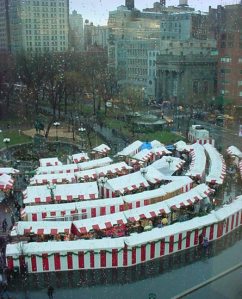As word of the performance crackdown at Washington Square Park spread in October, Parks Department spokesperson Phil Abramson told the Villager:
“At Washington Square Park the existing regulations are intended to keep paths clear and allow all park users to move about freely and see monuments and views,” said Philip Abramson. He confirmed that performers must stand 5 feet away from benches and cannot perform within 50 feet of a monument or fountain.
To be clear, these “existing regulations” had never existed before. They were written for artist vendors selling their wares (it was controversial with that application) in the city’s public parks.
The crackdown and ticketing of performers at Washington Square Park has nothing to do with blocking views, paths or monuments. Likewise, the restriction of artists at Union Square Park is not about that.
The Parks Department has no problem with the Holiday Market (pictured above) now in place at Union Square Park – from which it makes over $1 Million. The Holiday Market clearly blocks paths, the 14th Street Plaza and views of the George Washington statue.
This is about controlling public space, money, and a loss of character and charm (the “blanding of New York City”) at our city’s public parks.
Last year, DNAinfo looked into the matter at Union Square:
The sprawling bazaar that takes over Union Square for the park’s annual holiday market has become a hub for gift-shopping New Yorkers.
But one local artist fighting with the Parks Department over its rules to limit street artists in the park the rest of the year sees the city’s preferential treatment of the market as a double standard he thinks could help his case.
Robert Lederman, the outspoken leader of the artists who filed a lawsuit to block the vendor restrictions, claims that money — not public safety or aesthetics, as the city purported — motivated the revised park rules.
Parks Commissioner Adrian Benepe admitted to a Daily News columnist that money was a big factor in welcoming the market, which pays the city $1 million to takeover the southern end of the park where street artists usually decamp. …
The Parks Department said the artists created hazardous conditions for pedestrians.
Lederman, who invoked the artists’ First Amendment right to sell there without having to pay the city, is hoping the Parks Commissioner may end up eating his words.
“That the city put a 200-vendor holiday market in the exact south plaza area where the new rules completely ban all artists shows the utterly false nature of the pretext,” Lederman told DNAinfo. “That Benepe publicly claims it’s okay because they paid him $1 million, is the icing on the cake.”
Lederman called the holiday market a “huge public safety threat,” claiming it blocks one of the city’s busiest subway entrances and obstructs monuments — which the artists must be 50-feet away from.
But the city’s law department argued that during the weeks the market operates, the park isn’t used as much anyway.
“…The Holiday Market is allowed during the time of the year when it does not significantly interfere with the use of the Park because weather conditions reduce the number of people who come to enjoy its facilities,” Gabriel Taussig, a chief in the Administrative Law Division of the NYC Law Department, said in an e-mailed statement.
That’s an interesting argument – the weather argument. People still come out of the subway in that location and walk through the park there, no matter what time of year it is. On milder days, people would be sitting or performing on the Plaza at Union Square. None of that can be done while the Holiday Market is there.
Since these articles appeared last year, the artist vendor – referred to by the city as “expressive matter” vending – restrictions were put into place at the city’s parks (Robert Lederman’s lawsuit against this is ongoing – a decision should be reached early next year).
The Parks Department’s interpretation of these rules, applying them to artists and musicians performing for donations, is new. It is being purposefully applied at Washington Square – and is yet another example of the city’s attempt to revise the image and historic usage of the park.
These rules, with their expanding applications, are about the Bloomberg Administration controlling and further privatizing our public spaces, not about protecting the public from “wayward” artists and musicians appearing on pathways and in our midst.


